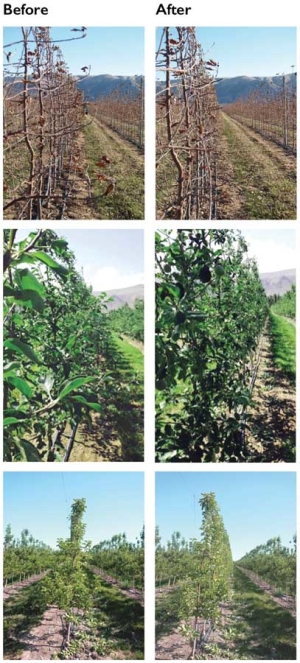Mechanical pruning is not just a labor-saving technique.

(Courtesy Karen Lewis/Washington State University)
In fact, the number-one goal of mechanical pruning, or hedging, is to improve fruit quality in terms of size and eating quality, says Dr. Stefano Musacchi, research pomologist with Washington State University in Wenatchee.
“I think we already have a nice level of yield,” he said. “If we expose fruit to the light they are sweeter compared to fruit developed in the shade. I’m thinking we have to look not only to maximize yield but to maximize quality because quality is the key issue.”
Musacchi and colleague Karen Lewis, WSU extension specialist, have been conducting trials in commercial orchards to study the effects of hedging, test various timings, and look at the impact of fruit sunburn.
They have trials in a Kanzi apple orchard owned by Columbia Fruit Packers and in Pink Lady and Fuji orchards owned by McDougall and Sons. They also have a trial with Cosmic Crisp (WA 38) at WSU’s Prosser research orchard.
In addition, Musacchi is evaluating mechanical pruning of Bartlett pears at a McDougall orchard at Monitor in the Wenatchee Valley.
Not new
Musacchi said mechanical pruning is not new. It was tried in Europe in the 1970s but didn’t catch on because apple trees were not grown on dwarfing rootstocks at that time and the pruning was done in winter, so the trees responded with vigorous growth.
“You will have a very strong reaction, and this will make your tree very angry with you and make it grow in a strong way,” he said.
Since then, French horticulturists have developed the concept of the fruiting wall, with closely spaced trees planted on dwarfing rootstocks. The trees are calmer and more balanced, with a structure made up primarily of small fruiting branches, and are easy to summer prune mechanically without fear of stimulating too much vigor.
When shoots and leaves are removed during mechanical pruning, it reduces the total amount of carbohydrate in the tree, but it also exposes the fruit to more light. A fruiting wall is typically only two feet deep.
Narrow canopies can be very efficient, Musacchi said. “We assume that all the leaves have the same efficiency, but that’s not true. When a leaf develops in the shade, it never becomes efficient like a leaf that develops in the sun, and you can have a lot of leaves, but the efficiency of your leaves is not full.”
When branches are pruned to maintain them within the same space, they can be efficient for a long time, he said.
Timing
When converting a slender spindle system to a fruiting wall, mechanical pruning is done in winter to avoid compromising the crop the following season.
It can be combined with an application of the growth regulator Apogee (prohexadione calcium) to prevent regrowth of long shoots.
As a maintenance operation, mechanical pruning is done in early summer, as needed. It does not have to be done every year.
Timing of summer pruning is typically when the shoots have grown 12 leaves (which in Washington is in early June) to stimulate induction of flower buds for the following year. Musacchi and Lewis are also testing a slightly later timing when the shoots have 20 leaves (June 15-20), which would give growers a wider time frame for getting the job done.
“In our light conditions here, I would like to see if we can play a little bit because the shoots are growing fast and we can’t do everything at the twelfth leaf,” Musacchi said. “I would like to know how many days we have available.”
Mechanical pruning cuts off the tips of the branches, which removes their inherent apical dominance. It has a similar effect to a hand-pruning cut that Musacchi calls a “tira savia.” It’s a short cut made in one-year-old wood, leaving two to three vegetative buds.
This helps to stimulate bud break closer to the trunk, or axe, of the tree and minimize blind wood. It also improves fruit quality because buds that are closer to the trunk produce larger fruit.
“We want short branches with a lot of spurs,” Musacchi said, noting that the ideal is to start off with a fruiting wall that has short branches, rather than convert an existing orchard.
Hand pruning is needed immediately after hedging because the vertical blades of the machine can’t cut across vertical branches or branches oriented parallel with the tree row.
Upright or pendant branches have to be removed by hand, but the cost is still less than if the orchard was fully pruned by hand.
Any fruit damaged during mechanical pruning can be targeted for removal during hand thinning.
Musacchi said not all orchards are suited to mechanical pruning at the same time. It should not be done if the trees are too weak.
“You have to evaluate when your orchard is ready to be pruned mechanically, because if you don’t completely fill the space, you can reduce your crop load,” he warned. “But, at the same time, when you start to prune, you reduce the size of the branches, and you have some help to complete the structure in the upper part of the canopy.”
He does not recommend mechanical pruning on angled canopies. The hedger can only prune the outside of the trees and not the wood in the middle of the V, so the effect is minimal. “It doesn’t justify the cost of running the equipment through,” he said.
The three-year project, which also includes trials with mechanical pruning of cherries, is funded by the Washington Tree Fruit Research Commission and is now in its second year. •






How do I find out where I can buy a tree hedger? Who builds them?